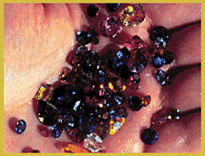
 Sapphires
Sapphires
If you were born in the month of September, sapphire is your birthstone. Sapphires and rubies are the gem varieties of the mineral corundum. Every color of gem corundum is called sapphire, except red, which is called ruby. All have a hardness of 9 on the Mohs scale of 1-10. Sapphires and rubies are tough gemstones as well, and that durability combined with their rarity and beauty make sapphires and rubies very desirable gemstones.
Fine, needle-like inclusions are what give sapphires their velvety quality. When these inclusions are numerous enough to make the stone translucent or opaque and are oriented properly, they allow light to be reflected in such a way that a star floats across the top of the stone with movement. When a cutter recognizes this potential in a piece of rough sapphire, he will cut it in a dome shape. Stars are not visible in faceted stones.
Cornflower blue sapphires are the most prized. These stones are rare and the finest examples come from Kashmir, a mountainous area in northern India on the Pakistan border. Geographic isolation, political instability and high demand all combines to make these stones very expensive.
Sapphires have been found in many other places in the world but few have attained the desirability of the Kashmir stones. In the United States, the Yogo Gulch area in Montana has historically produced some fine sapphires but few of these attain the size of the fine Kashmir gems. Labor and mining costs have been very high in the United States and the Yogo Gulch mines have generally not been profitable for the operators.
Fee localities are areas where one can pay a set fee for the privilege to extract gems and minerals from mines or claims that are owned by a second party. There are several such fee locality sapphire mines in Montana that have been profitable for both the mine owners and the prospectors who have chosen to pay the fee.
In addition to sapphire being found in Montana, some stones have also been produced from mines in North Carolina where several fee localities exist. Alluvial gravel that covers much of the North American mid-continent has also produced an occasional sapphire for the lucky prospector. In the Old World sapphire has been found in alluvial gravel in Burma and Sri Lanka. Many of the colorless stones from Sri Lanka can be enhanced by heat treatment. There are many other localities of lesser importance throughout the world that have produced sapphires.
Ancient Persians believed the Earth rested on a sapphire and its reflection colored the sky, hence it's often called the celestial gemstone. Tradition claims that Moses was given the ten commandments on tablets of sapphire, making it the most sacred gemstone.
Damigeron, a historian of old, wrote that sapphire was worn by kings to protect them from harm. It was also believed that sapphire would protect the wearer from envy and attract divine favor. The gem was regarded as a symbol of truth, sincerity and constancy.
Legend has it that if a poisonous snake were put into a vessel along with a sapphire, the rays from the gem would kill it. Our ancestors interpreted this to mean that sapphire was an antidote against poison.
The Sinhalese believed the star sapphire would protect them against witchcraft. The three intersecting rays were thought to represent faith, hope and destiny. Museums the world over exhibit star sapphires that are noteworthy for size or quality. The 543-carat "Star of India" resides in the Morgan-Tiffany Collection in the American Museum of Natural History in New York City.

Prince Charles of England chose a sapphire and diamond ring to seal his betrothal to Lady Diana Spencer.